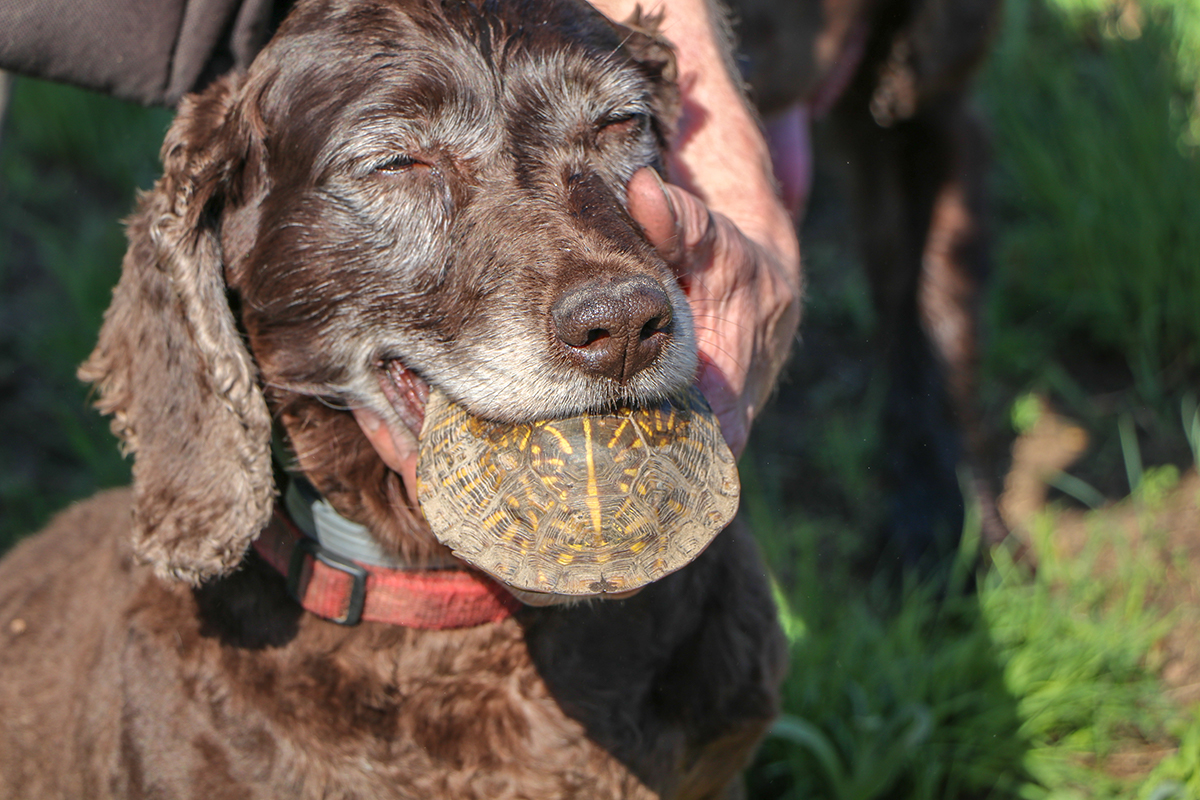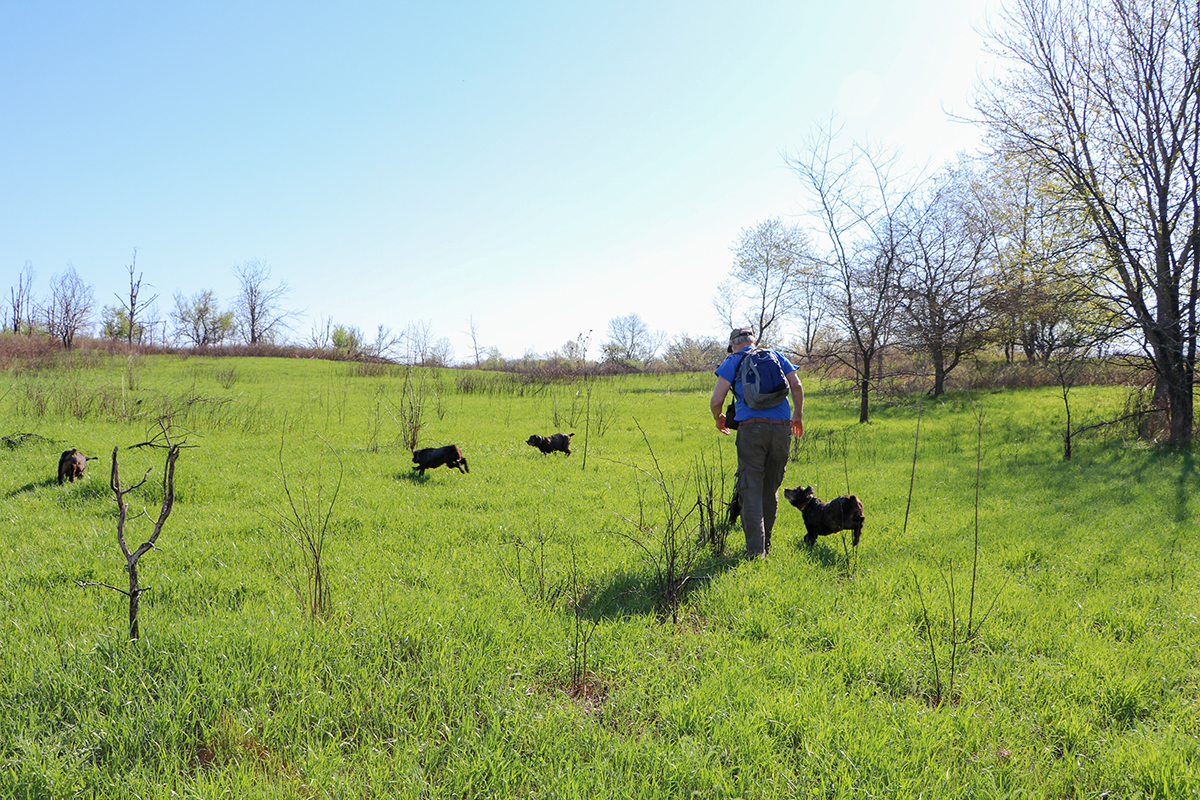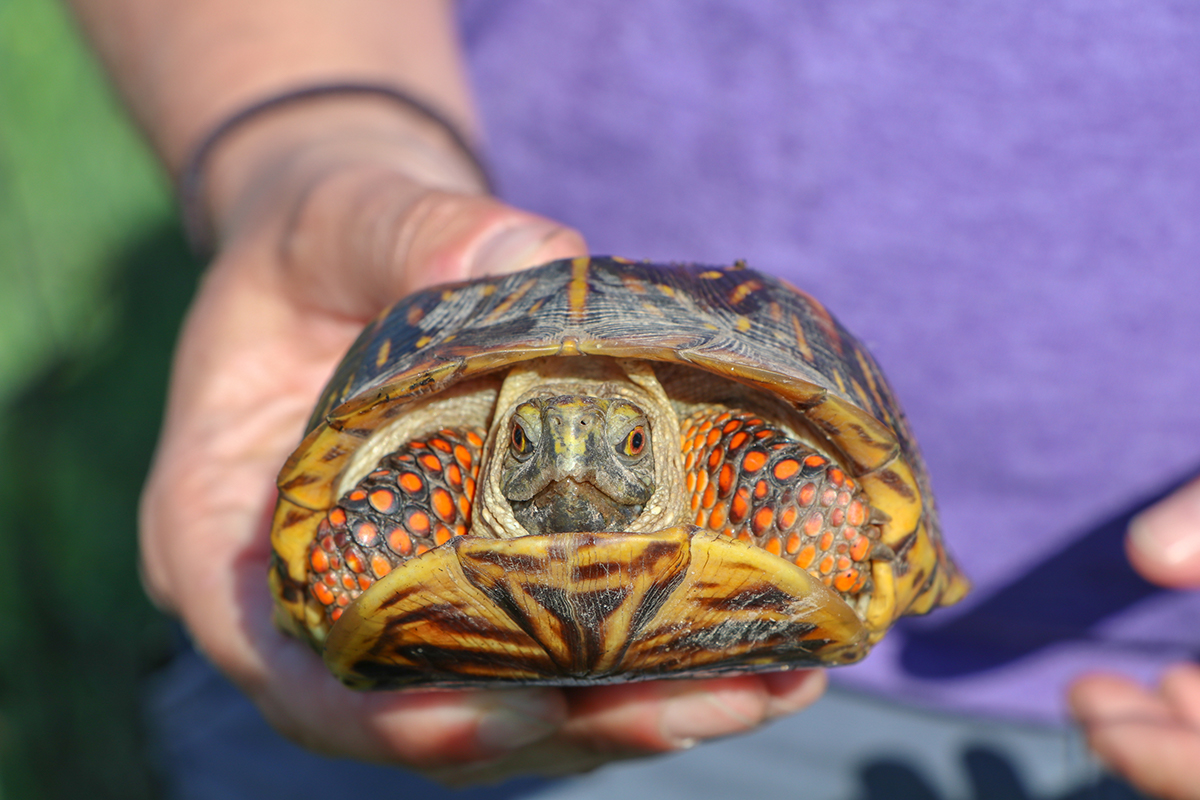It’s a fine May morning, and until a couple of minutes ago, the search for ornate box turtles here at the Conservancy’s Nachusa Grasslands Preserve in Central Illinois was going extremely well. We are up to 16 turtles on the morning so far.
Unfortunately, progress has come to a halt because the field assistants found the remains of something that might once have been a bison. And now they’re rolling in it. With glee.
“Well,” says John Rucker, as he surveys his mucky, happy charges. “Getting that smell out of their coats is going to be a project.”
Rucker gives a few quick commands and his field assistants – four female Boykin spaniels – finish their impromptu break, and get back to the job at hand: namely, tracking and retrieving every ornate box turtle they can find in these restored and remnant native prairies.
Yes, retrieving. I expected the tracking. The retrieving part came as a bit of a shock.
“The dogs find more ornates in two or three hours than we’d probably find in a whole week or even longer,” says Matt Allender, the team leader for the University of Illinois scientists at Nachusa this week, many of whom are grad students, doctoral candidates and post docs working on projects related to reptile health. “We couldn’t do this project without John and the turtle dogs. They’re part of the team.”

These medium-sized spaniels with their amber eyes and thick, brown coats that shine like copper in the sunshine were originally bred in South Carolina for bird hunting. But the breed also produces, as Rucker discovered by accident some years ago, a few special individuals who turn out to make excellent, well, turtle retrievers.
“They have very soft mouths,” Rucker explains as Jenny Wren (who has been finding the majority of turtles this morning) lopes up with the latest ornate find, which will be turtle number 19 by my count.
Jenny sits obediently at John’s feet, holding up her prize – like it’s some kind of reptilian tennis ball — and I can see that her tongue is between her bottom teeth and the turtle’s plastron (the bottom of its shell). She’s holding the ornate so lightly, I don’t feel any resistance when I slip it from her mouth. And the turtle shell is not even slobbery like a tennis ball would be.

“I have the turtle,” I say to one of the nearby scientists who is busy logging the exact GPS coordinates where Jenny Wren first found the turtle. It’s important to record the location precisely so the scientists, once they finish their tests, can return the turtles (by human hand this time) to the exact same place they were originally found.
“See?” Rucker says as he bends down to pet and praise Jenny. “The dogs are very gentle and they carry the turtles without injuring them. Ornates, blandings, Eastern box turtles, wood turtles, they can track and retrieve them all.”
Ornate box turtles, which tend to grow to around five to seven inches in length, are known for their beautiful backs (the carapace). To me, their shells look like a night sky full of yellow starbursts. They are true box turtles – one of the few turtles capable of completely sealing themselves inside their shells for protection from predators.

Which helps protect the adult turtles from, say, raccoons and badgers, but does little to thwart farm machinery and cars. The conversion of native Illinois prairie to farmland and pasture is one of the main reasons ornates are listed as a threatened species in Illinois.
Nachusa Grasslands has several populations of ornates, but Bill Kleiman, the preserve manager, would like to know more about how healthy and viable they are. Are there enough turtles of different ages to sustain ornates on the preserve into the foreseeable future? Are they healthy? Diseased? Injured? He needs to know more to inform the way the preserve is managed.
The bottom line, he says, is that “we want a lot more turtles here, and to make that possible, we need to understand many different aspects of our current population.”
It’s that need for more data – more evidence to inform the science behind the Preserve’s ongoing restoration and management — that brings Allender and his crew, and John Rucker and his spaniels to Nachusa this week. The scientists have set up a temporary field station under a tan canvas tent where they’ll be assessing all the turtles they collect.
Honestly, the set up – with its colorful canvas camp chairs and folding tables covered with scientific instruments — looks like a cross between a high-tech lab and a tailgate party. And as I watch the scientists go to work on the specimens they’ve collected this morning (22 by my last count), I keep thinking it’s a little like all those stories people tell about alien abductions. Only with turtles.

There are tackle boxes full of test tubes and slides, selections of syringes for drawing turtle blood, pipettes, cotton-tipped swabs, laser thermometers, electronic scales for gathering weight data, and even a portable doppler monitor. Most commonly used to monitor human fetal heart rates, the monitor also works great for monitoring ornate turtle heart rates. The scientists are looking in turtle eyes and down turtle throats, listening to their hearts, taking their temperatures and just generally giving each ornate a thorough – and thoroughly recorded – check up.
Over the coming days, weeks and months, they’ll be analyzing the blood they’ve taken and sequencing the DNA they’ve collected to learn more about the health and genetic makeup of the ornate populations here at Nachusa.
The thing is, all of this technology – all of the gear and potential – is useless without turtles to use it on. After all, notes Allender, “it’s hard to assess the health of turtles when you can’t actually find any.”
And to find them, the scientists need John Rucker and his turtle dogs.








That’s the beauty of my day with the turtle dogs at Nachusa – even as field science becomes more and more high tech with portable DNA sequencers and fetal heart rate monitors with transducers small enough to fit under an ornate box turtle’s shell, there’s still nothing like muddy boots canine-assisted field science to get the job done.
Because, ultimately, it’s not just about the turtles. It’s about what the ornate box turtle populations at Nachusa Grasslands signal about the health of the preserve overall.
“We need to understand the turtles,” Kleiman explains, “because they are such a signature prairie species. If we have healthy population numbers, with many different ages of individual turtles, then we know that our prairie – our remnants and restored prairies – are functioning the way they’re supposed to. The turtles help us know if we’re succeeding or failing.”




Join the Discussion